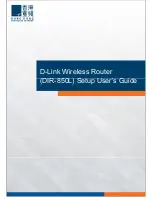
TL-WA601G
108M Wireless Access Point User Guide
Appendix A: Glossary
108M Super G
™
WLAN Transmission Technology
-
108M Super G
™
WLAN Transmission
Technology employs multiple performance-enhancing techniques including packet bursting, fast
frames, data compression, and dynamic turbo mode that combine to improve the throughput and
range of wireless networking products. Users can experience link rates of up to 108Mbps, twice
the industry-standard maximum data link rate of 54Mbps, while preserving full compatibility with
traditional 802.11g or 802.11b networks. 108M Super G
™
products offer the highest throughput
performance available on the market today. In dynamic 108M mode, the device can attach
802.11b, 802.11g and 108Mbps Super G
™
devices at the same time in an integrated environment.
2x to 3x eXtended Range
TM
WLAN Transmission Technology -
The WLAN device with 2x to 3x
eXtended Range
TM
WLAN transmission technology make its sensitivity up to 105 dBm, which
gives users the ability to have robust, longer-range wireless connections. With this
range-enhancing technology, a 2x to 3x eXtended Range
TM
based client and access point can
maintain a connection at as much as three times the transmission distance of traditional 802.11b
and 802.11g products, for a coverage area that is up to nine times greater. A traditional 802.11b
and 802.11g product transmission distance is about 300m. A 2x to 3x eXtended Range
TM
based
client and access point can maintain a connection transmission distance may be up to 830m.
802.11b -
The 802.11b standard specifies a wireless networking at 11 Mbps using
direct-sequence spread-spectrum (DSSS) technology and operating in the unlicensed radio
spectrum at 2.4GHz, and WEP encryption for security. 802.11b networks are also referred to as
Wi-Fi networks.
802.11g -
specification for wireless networking at 54 Mbps using direct-sequence
spread-spectrum (DSSS) technology, using OFDM modulation and operating in the unlicensed
radio spectrum at 2.4GHz, and backward compatibility with IEEE 802.11b devices, and WEP
encryption for security.
Access Point (AP) -
A wireless LAN transceiver or "base station" that can connect a wired LAN to
one or many wireless devices. Access points can also bridge to each other.
DNS
(
D
omain
N
ame
S
ystem)
–
An Internet Service that translates the names of websites into IP
addresses.
Domain Name -
A descriptive name for an address or group of addresses on the Internet.
DoS
(
D
enial
o
f
S
ervice)
-
A hacker attack designed to prevent your computer or network from
operating or communicating.
DSL
(
D
igital
S
ubscriber
L
ine)
-
A technology that allows data to be sent or received over existing
traditional phone lines.
ISP
(
I
nternet
S
ervice
P
rovider)
-
A company that provides access to the Internet.
MTU
(
Maximum Transmission Unit
)
-
The size in bytes of the largest packet that can be
transmitted.
SSID -
A
S
ervice
S
et
Id
entification is a thirty-two character (maximum) alphanumeric key
identifying a wireless local area network. For the wireless devices in a network to communicate
with each other, all devices must be configured with the same SSID. This is typically the
configuration parameter for a wireless PC card. It corresponds to the ESSID in the wireless
Access Point and to the wireless network name.
33




































